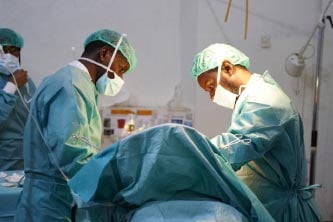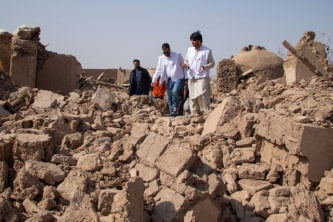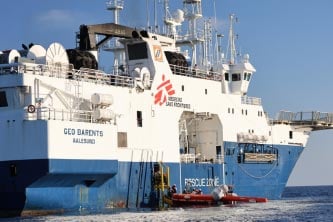Jerusalem - Dozens of Palestinians were killed and hundreds more injured today, as they waited for food at the newly-created Gaza Humanitarian Foundation distribution centres in Rafah, Gaza Strip, Palestine, and close to the Netzarim Corridor, according to the Ministry of Health. Médecins Sans Frontières (MSF) teams joined the mass casualty response in Nasser hospital, Khan Younis. Patients told MSF they were shot from all sides by drones, helicopters, boats, tanks and Israeli soldiers on the ground.
“Today’s events have shown once again that this new system of aid delivery is dehumanising, dangerous and severely ineffective,” states Claire Manera, MSF emergency coordinator. “It has resulted in deaths and injuries of civilians that could have been prevented. Humanitarian aid must be provided only by humanitarian organisations who have the competence and determination to do it safely and effectively.”
MSF teams at Nasser hospital treated patients with serious injuries today. Some patients in critical condition are still undergoing surgery. But with the blood banks almost empty, medical staff themselves have had to donate blood.
“The hospital corridors were filled with patients, but unlike what I have witnessed before, where most of the patients were women and children, today it was mainly men,” says Nour Alsaqa, MSF communications officer. “They lay in their beds in the hallways because the rooms are already packed with injured people. They had visible gunshot wounds in their limbs, and their clothes were soaked with blood.”
“They looked shattered and distraught after trying to secure food for their children, returning instead injured and empty handed,” Alsaqa continues. “Outside, there was shouting, sirens, a constant rush of new arrivals to the emergency room.”
“Amid the chaos, we received confirmation that a colleague’s brother had been killed while attempting to collect aid from the distribution centre,” she adds.
”People fought over five pallets. They told us to take food—then they fired from every direction,” says Mansour Sami Abdi, a father of four, who described the chaos. ”I ran 200 metres before realising I’d been shot. This isn’t aid. It’s a lie. Are we supposed to go get food for our kids and die?”
I ran 200 metres before realising I’d been shot. This isn’t aid. It’s a lie. Are we supposed to go get food for our kids and die?Mansour Sami Abdi, a father of four who was shot
“I was shot at 3:10am. As we were trapped, I bled constantly until 5:00am,” says Mohammad Daghmeh, who is displaced in Al-Qarara, Khan Younis. “There were many other men with me. One of them tried to get me out. He was shot in the head and died on my chest. We had gone there for nothing but food — just to survive, like everyone else.”
This is the second time this new system of aid distribution has led to bloodshed. On 27 May, the first afternoon of distribution in Rafah, Israeli forces shot dozens of people, as wholly insufficient amounts of basic lifesaving supplies were distributed amid chaos.
As a result of the total siege that was imposed by the Israeli authorities on 2 March, 100 per cent of Gaza is now at risk of famine, according to the United Nations. Since 19 May, the few hundred food trucks brought in – an insufficient fraction of what is needed – have spread despair among the more than 2 million people who have been largely deprived of food, water, and medication for three months now. Totally or partially blocking humanitarian aid to enter Gaza has aggravated the situation of all Gazans.
MSF reinforces that, along with displacement orders and bombing campaigns that kill civilians, weaponising aid in this manner may constitute crimes against humanity. Only a lasting ceasefire and the immediate opening of Gaza’s borders for humanitarian aid – including food, medical supplies, fuel and equipment – can ease this man-made catastrophe.





![Photos of Displaced Lives [Gaza] - Documentary series Photos of Displaced Lives [Gaza] - Documentary series](https://img.msf.org/AssetLink/yfuly0k6tgr80m223ju8inv7xe1mnf07.jpg)
